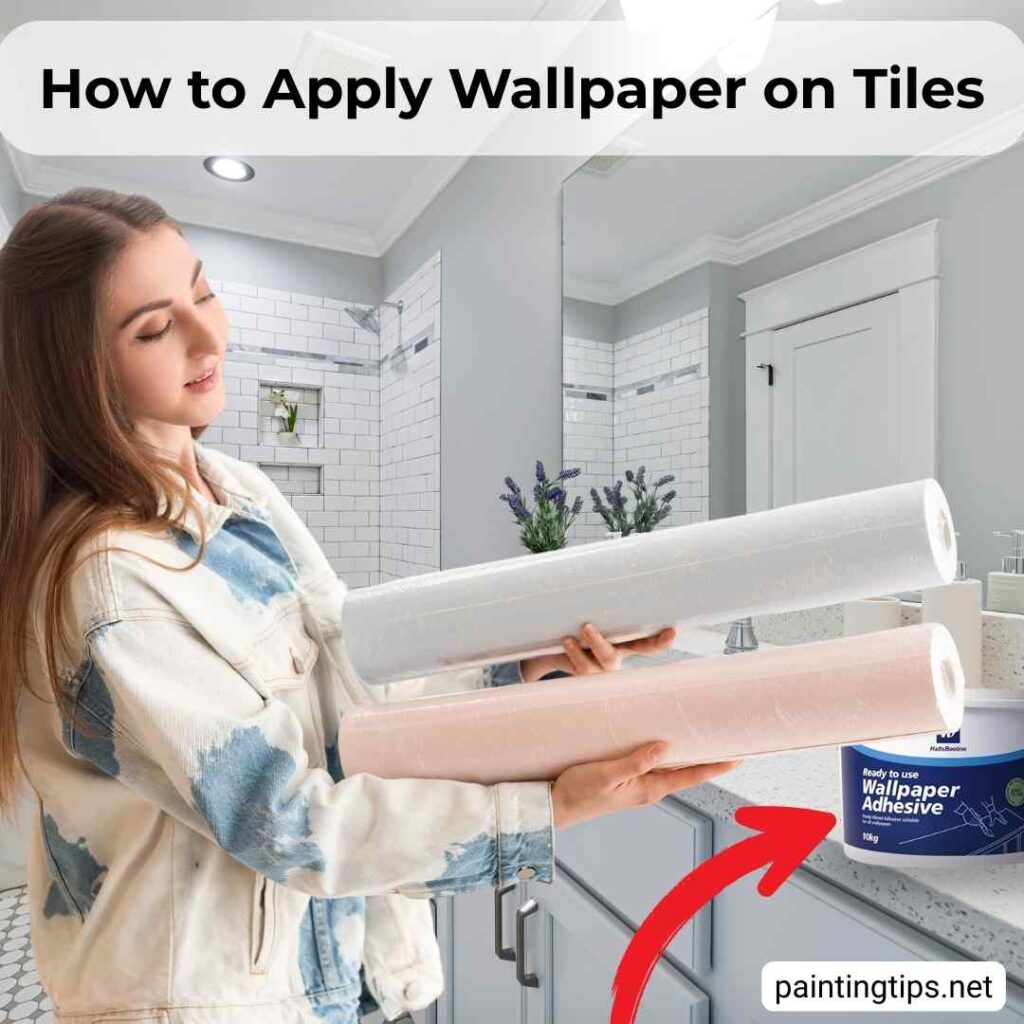Applying wallpaper over tiles can be a creative way to refresh your bathroom or kitchen without a full renovation. However, since tiles are smooth and non-porous, wallpaper doesn’t naturally stick well to them. Moisture, steam, and visible grout lines can make the process even more challenging, especially in bathrooms. With the right materials and techniques, though, it’s possible to achieve a stylish, long-lasting finish. In this guide, you’ll learn step-by-step methods for putting wallpaper over tile, the best adhesives to use, and tips for hiding grout lines for a smooth, professional look.
Can You Put Wallpaper Over Tiles?

Even on painted walls, some wallpaper professionals apply a layer of bonding primer or wallpaper primer before hanging the wallpaper. This ensures the wallpaper adheres better to the wall. The same cautious approach applies to tile surfaces, which are non-porous.
Standard wallpaper is made for porous surfaces. For wallpaper to stick strongly to any surface, it must be porous. In other words, the surface should be made of wood, plaster, or a paint finish with porous properties. Wallpaper adhesives are also manufactured with this in mind. Therefore, directly applying wallpaper to tile is not a correct practice. If you put wallpaper over tile, it will begin to peel off after a short time.
So, how do you put wallpaper on tile? There are ways to apply wallpaper to tile, but these methods are often riskier than traditional wallpaper installation. Especially in bathrooms, wallpaper will face two major challenges: the non-porous, smooth surface of the tile and the hot steam from the bathroom.
Another drawback of applying wallpaper to tiles is the grout lines between them. These lines might be visible through the wallpaper. However, there is a way to camouflage them: by using patterned, colorful, and thicker wallpapers. Also, a primer wallpaper can help mask the grout lines. Here are all the tips for applying wallpaper over tile.
How to Put Wallpaper on Tiles
Before you start applying wallpaper on tiles, it’s important to know that tiles are smooth and non-porous, which makes sticking wallpaper more challenging than on regular walls. To achieve a durable and neat finish, you’ll need to prepare the surface properly and choose the right adhesive or alternative products. Here are the methods you can use to successfully put wallpaper over tile.
1-Contact Adhesive

Contact adhesives are versatile adhesives that can bond a wide variety of materials. They work well on both porous and non-porous surfaces. However, they dry quickly, so you should work in small sections. Apply a thin layer of contact adhesive to the tile with a brush, wait for about 3 minutes, then press the wallpaper onto the tile. Use a plastic spatula to remove any air bubbles.
This method works for applying wallpaper to tile, but you need to ensure the adhesive is spread evenly over the tile and remove any trapped air as soon as the wallpaper is placed.
2-Ready-to-Use Wallpaper Adhesive

Ready-to-use wallpaper adhesives are effective for both porous and non-porous surfaces like tile. These adhesives are usually stronger than standard wallpaper adhesives and come in a cream form. Therefore, they should be applied with a plastic spatula to the tile. Apply the ready-to-use wallpaper adhesive with a spatula, then immediately place the wallpaper on the surface and adjust as needed.
3-Peel and Stick Wallpaper

Peel and stick wallpaper is one of the easiest options for applying wallpaper to tile. It adheres well to non-porous surfaces like tile. However, the most significant challenge with peel-and-stick wallpapers is the seams. Since the wallpaper sticks immediately, it will be difficult to adjust the seams once they are in place.
4-Vinyl Backsplash

Vinyl backsplash sheets are similar to peel-and-stick wallpapers, but they are thicker. As a result, they are easier to apply and adjust the seams. Their waterproof and durable structure makes them ideal for use in bathrooms, especially over tile. Additionally, their thickness helps conceal the grout lines between tiles.
Additional Tips
- No matter which wallpaper you apply over tile, using a wallpaper liner can help conceal the grout lines.
- Thick wallpapers are a good choice for hiding grout lines.
- Remember that applying wallpaper over tile may leave adhesive residue on the tiles.
- Before applying wallpaper to tile, ensure the tiles are dry and clean.
Frequently Asked Questions
Can You Put Peel and Stick Wallpaper over Tile?
Yes, it is possible to apply peel-and-stick wallpaper over tiles. However, the grout lines between the tiles may be visible.
Can You Put Self Adhesive Wallpaper over Tiles?
Yes, you can apply self-adhesive wallpaper over tiles. If you choose thick and patterned ones, you can prevent the grout lines from being visible.
Can you Put Wallpaper on Bathroom Tiles?
Yes, you can apply wallpaper to bathroom tiles. However, the humid environment of the bathroom and the non-absorptive nature of the tiles will increase the risk of application. If the steam from hot water in the bathroom can dissipate quickly, you can apply wallpaper to the bathroom tiles using contact adhesive or ready-made wallpaper adhesive. “Related article: How to clean grout between tiles“
Can You Wallpaper Over Kitchen Tiles?
Yes, you can apply wallpaper over kitchen tiles, but make sure the tiles are clean, grease-free, and dry before applying the wallpaper. Also, consider using strong adhesives like contact adhesive or ready-made wallpaper adhesive for better adhesion. “Related post: How to change the color of kitchen cabinets without painting.”